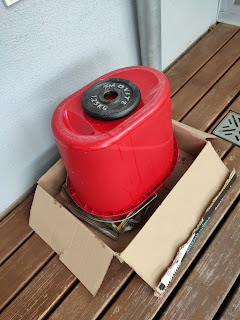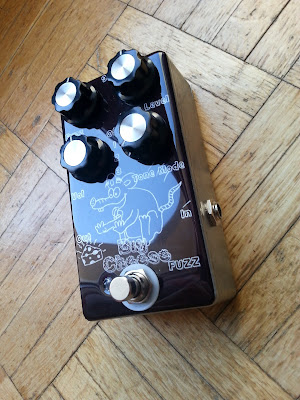Tutorial: How to finish pedal enclosures with epoxy resin
Ive been asked quite a few times, how i do my pedal enclosures. Thats why I decided to do a full tutorial on this blog, since its not only to show my work, but also to inspire, share knowledge and help others.
There are some ways to get designs on pedals, not only for labelling controls but also to make them look prettier. Most popular methods are using decals and finish them with enamel or epoxy resin, or use the edging techique. Ive tried most of them and epoxy resin works the best for me.
If you wanna use decals on pedals, you need to fnish them to protect them, so they are not destroyed or worn off. Epoxy is really cool, because its a pretty thick layer of protection and has a glossy look to it, which I like.
What is epoxy resin?
Generally epoxy resin is a transparent thick liquid, that hardens after some time when mixed with a hardener substance. When you buy epoxy resin, you get two bottles: a resin and a hardener. These two has to be mixed together, usually with a 1:1 ratio (depends on the product). Common brand of epoxy resin is envirotex (popular especially in the US).
Epoxy is usally non toxic and not dangerous. Just make sure to avaoid direct contact with the body, clothes etc, since its very sticky and hard to wash off. Also watch out to protect your tables, floor etc.
Epoxy resin is commonly used for furniture and wood finished, also for gardening work. I find it to be underrated in pedal building.
What do you need?
Checklist whats necessary and recommended to start off with finishing your pedal.
- Drilled pedal enclosure (usually aluminium)
- Carpet knife
- Epoxy resin with hardener
- Cup and stick for mixing the resin. The cup must be clean and dry
- Gloves
- A scale
- Wide tape (gaffa tape for example) if you want to avoid the sides.
- Cardboard or plastic tape for protection of table, floor (i always use cardboard)
- Some thing to place your pedal on, so its not in direct contact with the floor (see later steps)
- Some bucket to protect the resin from insects, dirt and hairs while hardening
Steps
1. Prepare your enclosure and decal
Prepare
your enclosure. Enclosure must be completely drilled. Also make sure
that the enclosure is clean of drilling edges, dirt and is also dry.

Print
out your decal. You can use transparent waterslide or sticker decals.
Since I have an inkjet printer I prefer using vinyl sticker decals,
since i dont need to use enamel before placing them on the enclosure.
Waterslide decals have the advantage that they can be moved after placed
on to the enclosure.
Make sure the decal is printed out in the right size and every label is in place. When using an inkjet printer, let the ink dry for at least half an hour after printing.
2. Cut out your decal
Cut out your decal with a scissor. Try to cut it out as approximately to the edges on the enclosure top as possible and also cut round the edges. Cut off little bit off the borders and always check with the enclosure by laying it on top. 
3. Apply decal on the enclosure and cut out the holes
Apply
the decal on the pedal enclosure. When using waterslide decals, place
the decal in water and wait for the decal to come off the paper. You can
move waterslide decals a bit after placing the on the eclosure, use a
towel and wipe the decal carefully to remove water on top and
underneath.

When using sticker decals, pull the paper off of one top edge. Place the edge on the enclosure and carefully place the sticker on from top to bottom. Then carefully press on the sticker decal and make sure it sticks everywhere and there is no air between the decal and the enclosure surface.
Use a carpet knife and carefully cut our the holes in the enclosure. Otherwise switches and pots cant be mounted :) Make sure the knife is sharp and watch out not to tear off or scratch the foil.
Place the enclosure on to the place where the resin will be applied.
4. Cover the sides of the pedal enclosure (if preferred)
If you do not want to apply resin to the sides of the enclosure,
use a wide tape (e.g.: gaffa tape) and place it on to the sides. Place
the tape so that there is a small space on top, so the resin can cover
the edges and has more stability. I try to get some photos ready of this
step.
This step should be considered, since it can be hard to get a good and even layer on the enclosure sides, since the resin rins down frop top to bottom. Also the resin can cover the bottom of the sides.
However in this example I also finished the side of the enclosure.
5. Preparing and mixing the resin
Before mixing the resin, make sure you have a place ready to place the enclosure on to. Also wear gloves.
Epoxy
resin always come with a bottle of resin and a hardener, both are thick
transparent liquids. Check the desciption on your resin, most resins
have a mixing ratio of 1:1.
I always recommend weighing the resin, because then you can be sure that the ratio is correct. Put a clean and dry plastic cup on your scale. Some epoxy sets come with cups and mixing sticks.
Fill the resin into the cup, usually almost half of the cup - dont go above half of the cup. Remember the weight. In my case i poured 14g of resin into the cup.
Then add the same amount of hardener liquid into the cup (if the ration is 1:1, otherwise you have to calculate). In my case I added 14g of hardener, which results into 28g of liquid.
Stir and mix the resin for some minutes. Go slow while mixing to avoid as many bubbles as you can. Continue stiring as long as there is nothing cloudy in the resin anymore and its completely clear.
6. Applying the resin on to the enclosure
Pour the epoxy resin on the enclosure. Make sure that the complete top and all edges of the enclosure are evenly covered. If you also finish the sides of the enclosure, check if resin is evenly applied there - you probably need to use a the stick or a brush a apply the resin evenly on the side. Layer on the side will be much thinner that the one on top.
Now you will probably have some bubbles in the resin. Make sure all bubbles disappear. You can do this by blowing or carefully using a fan. Also sometimes you can remove bubbles with the stick. Be very careful and dont touch the liquid with your face or hair.
Double check if all bubbles are gone and that there is no dirt or hairs in the resin. This process may take some time, take your time.
7. Drying process
After you are satisfied with the appliance of the resin, cover the enclosure with something that protects the resin from dirt, hair and insects. I use a plastic bucket for this, with a weight on top.
Let the resin dry for at least 24 hours. After this the resin should be hard and ready to work with. Epoxy resin will be completely hardened after 72 hours (3 days).
If the resin is hardened, carefully remove the enclosure from the surface and eventually remove the side tapes. Remove resin drops which in the enclosure inside, which occur because the resin rins down though the holes. You can use pliers to remove these drops.
If theres some resin at the bottom of the sides, remove them carefully with a carpet knife.Be careful because dried resin can easily produces cracks. Also cut out holes again with the knife, if necessary.
This should be the result.
Common errors
I
have failed many times and miserably, but its always a learning
process. Mistakes happens. Here are some Ive experienced, hopefully you
can learn from them.
Resin does not harden or is sticky
If the resin is still sticky after 24 hours, theres something wrong. Most probably the resin hardener ratio is not correct or it has not been mixed properly. You need to start all over again.
The resin is cloudy on top
If the resin is fully hardened but still not completely clear, most probably the resin has not been mixed well or the ratio is not correct.
Surface is uneven or dirty
Most common error is that some dirt or hair gets stick in the resin during drying. This cannot be removed after hardening proces is done. You need to see how bad it is, either live with it or start all over again.
When the surface is uneven, it could have some reason. Either the enclosure was not placed on a completely even ground, or too little resin was applied on top or ran off.




















































